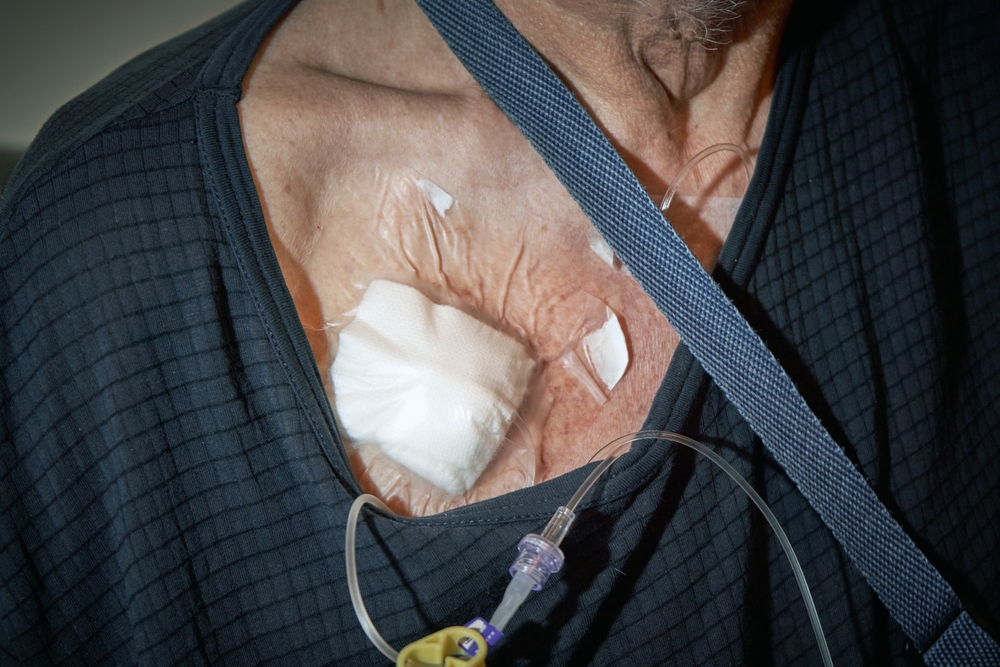Did You Suffer Complications From a Port-a-Cath Device?
Port-a-Caths, also known as implanted ports, can result in serious injuries such as catheter failure, fracture, infection, and migration. Victims of these injuries may be eligible to seek compensation through product liability lawsuits.

Start My Port-a-Cath Fracture Lawsuit Claim Now
port-a-cath Lawsuit
Port-a-caths, also known as implanted ports, can result in serious injuries such as catheter failure, fracture, infection, and migration. Victims of these injuries may be eligible to seek compensation through product liability lawsuits.
Port-a-cath injuries have become a topic of concern and scrutiny in recent years. A port-a-cath, also known as an implanted port, is a small medical device implanted under the skin that allows for easy access to a patient’s veins. It is commonly used for long-term intravenous treatments such as chemotherapy or dialysis. However, complications can arise from the use of port-a-cath devices, leading to patient harm and the need for legal recourse. Port-a-cath lawsuits generally revolve around side effects and complications like device malfunction, fracture or migration, port infection, blood clots, or cardiac issues.
As the number of patients relying on port-a-caths for their treatment continues to grow, understanding the legal implications and potential risks associated with these devices is vital for patients, healthcare professionals, and manufacturers alike. If you or someone you love has suffered an injury or complication allegedly associated with a port-a-cath device, call us today or fill out the form to learn more. We can help put you in touch with an attorney who specializes in product liability claims.
What is a Port-a-Cath?
A port-a-cath, also known as an implanted port, is a medical device that is often used to facilitate the administration of medications, chemotherapy, blood transfusions, and intravenous nutrition. It consists of a small reservoir, or port, that is implanted beneath the skin, usually in the chest or arm, and connected to a catheter that is inserted into a vein. The port allows healthcare professionals to easily access the vein for the delivery of medications and fluids.
One widely used port-a-cath device is C.R. Bard’s PowerPort implantable port and catheter system. This and other port-a-cath devices have been the subject of product liability lawsuits alleging that the manufacturers were aware of reports of serious complications and injuries associated with their devices and failed to make design adjustments to make them safer and more effective and to protect patients from unnecessary harm.
Alleged Side Effects Leading to a Port-a-Cath Lawsuit
While they are generally considered safe, there have been potential complications associated with the use of port-a-caths, including infection, clotting, blockage, and damage to blood vessels or nerves during insertion or removal. Unfortunately, some individuals who have undergone port-a-cath implantation have experienced serious complications that have led to lawsuits against the manufacturers of these devices. These complications include:
Fractured/Cracked/Broken Device
One of the primary concerns with port-a-caths is the risk of device fracture, where the catheter or other components of the device break or crack. This can lead to serious complications, such as migration of the broken pieces, punctures to blood vessels or organs, and internal bleeding.
Migrated Device
In some cases, the port-a-cath may migrate from its intended position, leading to complications and potential damage to surrounding tissues and organs. Migration can occur due to various factors, including improper placement during the initial implantation procedure or device defects.
Infection of Device
Another potential complication of port-a-caths is device-related infections. The insertion site and the catheter itself can become infected, leading to serious health risks and the need for additional medical treatment. Infections can be caused by factors such as improper sterilization procedures, poor maintenance of the device, or design defects.
Blood Clots/Thrombosis
The presence of a foreign object, such as a port-a-cath, within the body can increase the risk of blood clots, particularly deep vein thrombosis (DVT) and pulmonary embolism (PE). If a blood clot forms and travels to the lungs or other vital organs, it can be life-threatening.
Pulmonary Embolism
Pulmonary embolism is a potentially life-threatening condition that occurs when a blood clot, usually from the legs, travels to the lungs and blocks the blood flow. Individuals with port-a-caths have an increased risk of developing pulmonary embolism due to the potential for blood clots to form around the device.
Sepsis
Sepsis is a severe infection that can spread throughout the body, potentially leading to organ failure and death. If a port-a-cath becomes infected and the infection is not promptly treated, sepsis can develop.
Endocarditis
Endocarditis is an infection of the inner lining of the heart, usually caused by bacteria or fungi. If bacteria or fungi enter the bloodstream through a port-a-cath, they can potentially infect the heart, leading to endocarditis.
Link Between Port-a-Caths and Serious Injuries
Research studies have been conducted to evaluate the potential risk of complications associated with port-a-caths. These studies have identified various side effects and complications, including catheter fractures, infections, blood clots, and cardiac issues. The findings of these studies provide valuable evidence for individuals pursuing lawsuits related to alleged port-a-cath complications. They can help establish a potential link between the use of port-a-caths and the development of specific injuries, strengthening the legal claims against the manufacturers.
If you or a loved one has experienced any of the above complications or other injuries related to a port-a-cath device, you may be eligible to pursue a lawsuit against the manufacturer of the device. Lawsuits can help affected individuals seek compensation for medical expenses, pain and suffering, lost wages, and other damages associated with their injuries. To pursue a lawsuit, it is important to consult with an experienced attorney who specializes in medical device injury claims. They can evaluate your case, gather necessary evidence, and guide you through the legal process.
Lawsuits Against Port-a-Cath for Complications
Several lawsuits have already been filed against the manufacturers of port-a-cath devices, including C.R. Bard and other companies. These lawsuits, filed in various states across the country, allege that the manufacturers failed to adequately warn patients and healthcare professionals about the risks associated with their port-a-cath devices, as well as design defects that make the devices prone to complications.
C.R. Bard has been named in port-a-cath lawsuits filed over problems with its implantable ports and product liability lawyers believe more defective product claims will be filed against manufacturers and hospitals in the coming months and years. In these product liability lawsuits, plaintiffs seek compensation for their injuries, including medical expenses, pain and suffering, lost wages, and other damages. The outcomes of these lawsuits can vary, but successful cases can result in substantial settlements or jury verdicts.
One notable port-a-cath claim was filed by the family of Jesus L. III against Texas Children’s Hospital. According to the port-a-cath lawsuit, Jesus had an AngioDynamics Vortex Port implanted in 2019. Within weeks, the device malfunctioned, causing broken pieces to migrate through his body and chemotherapy chemicals to leak under his skin, leading to devastating consequences that required surgery to remove the port. Sadly, Jesus died in May 2021. Lawsuits like these highlight the importance of patient safety and the need for accountability within the medical community.
The U.S. Judicial Panel on Multidistrict Litigation (JPML) recently centralized all Bard PowerPort implantable port and catheter claims in the District of Arizona as part of a multidistrict litigation (MDL). U.S. District Judge David G. Campbell will oversee the discovery phase and preside over pretrial proceedings in the Bard port-a-cath MDL.
Port-a-Cath FDA Recalls
While legal claims involving port-a-caths are relatively recent, the potential risks associated with these devices have been evident for many years. The first time the FDA recalled a port-a-cath device was in 2004, and since then, several more port-a-cath recalls have been issued. One of the most noteworthy port-a-cath recalls took place in 2017, when Cook Medical recalled 31,000 Vital-Port Vascular Access Systems. The recall was initiated due to the risk of the device releasing silicone pieces into the bloodstream, causing harm and hindering medication delivery. It is important to note that just because a medical device has been recalled does not necessarily mean all doctors will notify their patients about the recall. If you have had a recalled device implanted or your doctor failed to inform you of a recall, it is crucial to seek legal advice promptly to explore your legal options.
Studies Linking Port-a-Caths to Side Effects
Study: The pathogenesis of catheter-related infection
Researchers find that imperfections on the surface of intravascular catheters may increase the risk of bacterial growth, possibly leading to infection and thrombosis. According to the study, this risk might be reduced if the catheters are coated with a surface-modifying additive.
November 2009Case Report: Migration of A Port-A-Cath in to the Heart
The Journal of Cardiology & Current Research publishes a case report involving a five-year-old boy whose central line catheter disconnected from the injection port and migrated into his heart.
September 2015Research highlights complications of central venous port systems
A study published in the journal Insights Imaging reports that the most common complications associated with implanted port systems are infection and catheter-related thrombosis. According to the researchers, “Radiologic assessment is of key importance to detect complications [...]”
August 2019Outcomes following port-a-catheter placement in the Medicare population
Research seeking to evaluate the long-term complication risk associated with port-a-cath placement is the first to show that “postprocedure arrhythmias occur at significant rates within the 5-year follow-up period.”
January 2021Why We Think the Manufacturer Should Be Held Liable
There are several reasons why the manufacturers of port-a-caths should be held liable for the side effects and complications associated with their devices. These reasons include:
- Failure to adequately warn: Manufacturers have a responsibility to provide accurate and timely information about the risks associated with their products. If they fail to warn patients and healthcare professionals about potential complications, they may be held liable for resulting injuries.
- Design defects: If the design of a port-a-cath is inherently flawed and increases the risk of complications, the manufacturer can be held responsible for any resulting injuries. Design defects can include materials that are prone to fracture, inadequate sterilization features, or other factors that contribute to device failure.
- Negligence: If a manufacturer fails to meet industry standards for the design, manufacturing, or labeling of a port-a-cath, they may be considered negligent. Negligence can form the basis for a legal claim and may result in compensation for the injured party.
- Concealment of information: If manufacturers have knowledge of potential risks associated with their products but fail to disclose this information to the public, they may be held liable for any resulting injuries. Concealment of information can be a significant factor in determining liability in product liability lawsuits.
Migration of A Port-A-Cath in to the Heart, Journal of Cardiology & Current Research
Complications of central venous port systems: a pictorial review, Insights Imaging
Outcomes following port-a-catheter placement in the Medicare population, Surgery Open Science
Medical Device Lawsuit

Start My Port-a-Cath Lawsuit Claim Now

What should you do? If you have suffered fractures, infections, blood clots, or other injuries allegedly caused by a port-a-cath device, you should contact a lawyer as soon as possible to discuss filing a port-a-cath lawsuit.
Start Your Claim Now!
Port-a-cath devices have provided significant benefits in the administration of medications and treatments for many patients. However, complications associated with these devices, such as fractures, infections, blood clots, and cardiac issues, have led to lawsuits against the manufacturers. If you or a loved one has experienced complications from a port-a-cath device, it is important to consult with an attorney specializing in medical device injury claims. They can evaluate your case, explain your legal options, and guide you through the process of pursuing a lawsuit against the manufacturer. Seeking legal representation can help you recover compensation for your injuries and hold the responsible parties accountable, so contact us as soon as possible for help.
- Fight to Get The Compensation You Deserve
- Experienced Port-a-Cath Attorneys Within Reach

